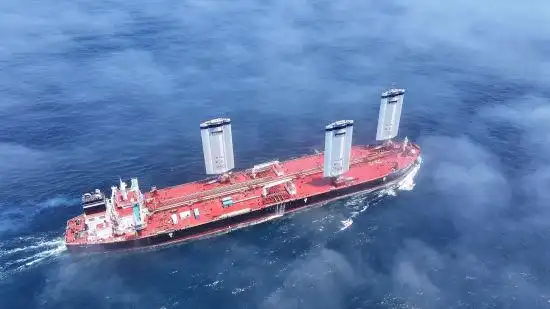On June 11, China officially unveiled the world’s first wind-assisted Aframax product oil tanker, a groundbreaking innovation that signals the shipping industry’s gradual shift toward smarter and greener operations. Built by Shanghai Waigaoqiao Shipbuilding under China State Shipbuilding Corporation, this tanker, named BRANDS HATCH, integrates cutting-edge “wind sail” technology into its massive design.
What Makes This Oil Tanker Different?
Unlike traditional oil tankers, this vessel is equipped with three enormous, 40-meter-tall silver wing-shaped structures. These are not fabric sails but hard-wing sails made from advanced fiberglass composite materials. Each sail can be fully automated via hydraulic systems and intelligent control platforms. With just one command from the cockpit, the sails can be raised, lowered, and adjusted to automatically capture optimal wind angles, functioning with a precision far beyond human capability.
This modern wind-assist system leverages wind power to complement the ship’s conventional fuel engine, creating a dual-power solution that is both more efficient and environmentally friendly.

Why Apply Wind Technology to Oil Tankers?
The Aframax-class oil tanker is a popular vessel in the international shipping market, known for its stability and wide-body design. These ships frequently operate in regions like the Indian and Atlantic Oceans, which are ideal for wind-powered propulsion due to their consistent seasonal winds.
When favorable wind conditions arise, the sails can significantly reduce the vessel’s reliance on engine fuel, cutting operational costs and reducing greenhouse gas emissions.
Modernizing an Ancient Technology
Historically, wind power was humanity’s first large-scale shipping solution. However, with the industrial revolution, fossil-fueled engines gradually replaced sails. Today, facing increasing global pressure to cut carbon emissions, China is leading a resurgence of wind-powered shipping through modern engineering.
Currently, China employs two types of wind-assist technologies:
- Rotor Sails: Tall rotating cylinders that generate thrust via the Magnus effect. These sails adjust their rotation speed based on wind direction to optimize propulsion.
- Wing Sails: The technology used on BRANDS HATCH relies on rigid airfoil-shaped sails that can harness wind power even when sailing against the wind by creating pressure differences across the sail surfaces.
A Step Toward Greener Shipping
The environmental benefits are significant. Real-world testing shows that with a wind speed of 20 knots, the tanker can save up to 14.5 tons of fuel per day, which equates to annual energy savings of 5% to 12% and nearly 5,000 tons of carbon emission reductions per year.
This technology is not limited to oil tankers—it has the potential to be widely adopted on bulk carriers and even cruise ships, further supporting the maritime industry’s global green transition.
Conclusion
By reviving and reinventing sail technology, China is offering a powerful solution to one of the most pressing challenges in international shipping: reducing carbon footprints without compromising efficiency. As environmental regulations tighten worldwide, wind-assisted vessels like BRANDS HATCH may soon become a mainstream solution, paving the way for a sustainable future in global maritime transport.
